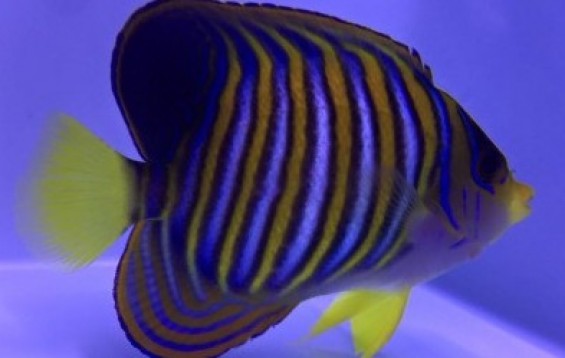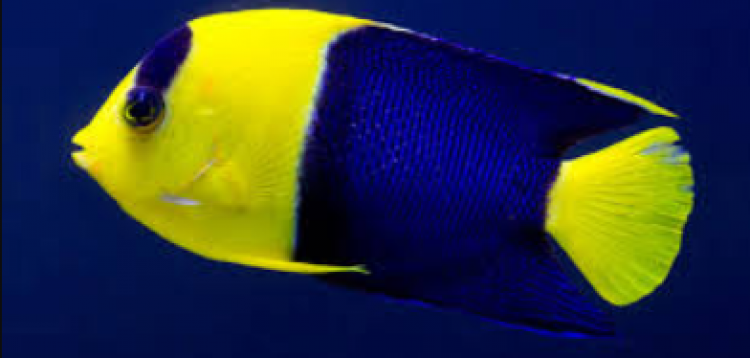- Name:
Regal Angelfish
(View AKA's) - Family: Pomacanthidae
- Species: Angel Large
- Scientific Name: Pygoplites diacanthus


More Details
General info about Regal Angelfish
With vivid vertical striations of blue, white, yellow, or orange on the body and pelvic fin, the Regal Angelfish deserves this distinctive name. Regal Angelfish from the Maldives and the Red Sea have a distinctive yellow breast, where their Indo-Pacific, Coral Sea, and Tahitian relatives normally have a blue/gray breast. This coloration is more prevalent in specimens that are more mature and are at least 4" in length. Regal Angelfish from the Red Sea, Maldives, Coral Sea, Fiji and Tahiti are good shippers and are harvested and handled with care, and normally will adapt more easily than their Indo-Pacific counterparts to the home aquarium. The Regal Angelfish is more difficult to maintain than other species of angels so it should be introduced first so that it may stake out its territory in advance of other fish. A large tank with plenty of hiding places and live rock for grazing will offer a good environment. The Regal Angelfish may nip at large-polyped stony corals, an occasional soft coral and clam mantles, but may be kept with small-polyped stony corals and somewhat noxious soft corals.
Regal Angelfish Diet & Nutrition
Regal angelfishes are carnivores and are known to feed on sponges and tunicates. In an aquarium setting, they are known to thrive on a varied diet consisting of food items such as nori seaweed, mysis shrimp, and chopped meaty fare.
Determining Sex of Regal Angelfish
The species is hermaphroditic and can change gender from female to male when the need arises.
Regal Angelfish Origin
Regal angelfish are widely distributed in the Indo-Pacific region ranging from the Red Sea and East Africa to the Tuamoto Islands, north to Ryukyu and Ogasawara Islands in Japan, south to Great Barrier Reef and New Caledonia.
Caution with Regal Angelfish
These angelfishes are very sensitive to detioriorating water conditions. A reef-type aquarium is ideal because it provides the rocky reef structure that the fish requires to feel secure. Regal angelfishes are also known to pick on corals particularly to large-polyped stony corals such as Trachyphyllia or certain soft coral such as Xenia. They will not thrive in an aquarium with aggressive feeders or fish with belligerent personalities, such as triggerfish and large wrasses.
Acclimating Regal Angelfish
The regal angelfish are very sensitive during transportation and acclimatizing in the tank. They should be added in mature tanks with live rocks where they can graze and hide when feeling threathened.
Relevent Articles
Original Detail
| Name | Species | Family | Scientific Name | More Detail | Added by |
|---|---|---|---|---|---|
| Regal Angelfish | Angel Large | Pomacanthidae | Pygoplites diacanthus | With vivid vertical striations of blue, white, yellow, or orange on the body and pelvic fin, the Regal Angelfish deserves this distinctive name. Regal Angelfish from the Maldives and the Red Sea have a distinctive yellow breast, where their Indo-Pacific, Coral Sea, and Tahitian relatives normally have a blue/gray breast. This coloration is more prevalent in specimens that are more mature and are at least 4" in length. Regal Angelfish from the Red Sea, Maldives, Coral Sea, Fiji and Tahiti are good shippers and are harvested and handled with care, and normally will adapt more easily than their Indo-Pacific counterparts to the home aquarium. The Regal Angelfish is more difficult to maintain than other species of angels so it should be introduced first so that it may stake out its territory in advance of other fish. A large tank with plenty of hiding places and live rock for grazing will offer a good environment. The Regal Angelfish may nip at large-polyped stony corals, an occasional soft coral and clam mantles, but may be kept with small-polyped stony corals and somewhat noxious soft corals. | PalaciosAn |





